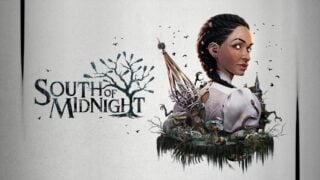Dance of Death: Du Lac & Fey
Admirable in ambition, but let down by maddening mechanics
- Game Director
- Jessica Saunders
- Key Credits
- Rhianna Pratchett (Story Consultant), Philip Huxley (Writer)

It’s like a fever dream, the kind you get when you’re drunk even though your prescription meds say you shouldn’t have alcohol and you’ve dozed off halfway through Jacob’s Ladder.
A mash-up of things we’re not sure anyone’s thought to mash-up before – who’d even think of putting together characters from the legend of King Arthur with the real-life crimes of Jack the Ripper? – Dance of Death: Du Lac & Fey is at once both brilliant and brilliantly dreadful, a unique but heady union of the sickening and surreal. From a mechanical point of view, though, Dance of Death: Du Lac & Fey is maddeningly frustrating. While a simple point and click adventure by design, your progress is hampered by unpredictable screen prompts and a lack of meaningful exploration.
Take talking to an NPC, for example; your instinct might be to click on the character themselves, but do that and your protagonist will only meander to a distant point behind them. Instead, you’ll learn – the hard way, like us – to click the ground in front of them. On the way to them, though, your character will probably, ad nauseam, snag themselves on environmental props and figures. And though there’s only a handful of still-life screens to visit, a 3D character wandering around in a 2D world makes navigating 1888’s Whitechapel painfully onerous.
When things are really bad, glitches and full-on game-breaking bugs will prevent progression entirely. We’ve had the Journal stop updating completely, no longer furnishing clues to our next waypoint, and a character we were tasked to follow refused to budge, leaving us to progress without him in the hope he’ll catch up in the next scene. There are no subsequent tips or clues if you find yourself stuck or missing an item, either.
Subtitles are often missing, inaccurate, and at times just woefully wrong, and both the combat and crafting mechanics – whilst simple enough once you’ve got the hang of them – are offered up to you with no direction at all. Though the background artistry is indisputably superb, characters you don’t interact with are peculiarly flat, standing out for all the wrong reasons against their fully realised, 3D peers (which takes away any challenge in deducing what characters you should approach in each scene, incidentally).
“The Ripper’s fiendish hold on Victorian Whitechapel is a time ripe for storytelling, and placing us as real victim Mary Jane Kelly is an intriguing premise, with many testimonial facts about Kelly’s final hours”
All that said, though? When it works, we enjoyed our time with Du Lac & Fey very much. The constant swaying from serious to satirical keeps the story marching on and it’s undeniably refreshing to have the narrative delivered from the perspectives of three key protagonists; Sir Lancelot (“Lac” – no, we don’t know why he’s in the story), Morgan le Fay (“Fey” – fabled to be Arthur’s half-sister and For Reasons is a talking dog now), and – a seed of fact in a field of whimsical fiction – the very real Mary Jane Kelly, widely thought to be Jack the Ripper’s final victim.
The Ripper’s fiendish hold on Victorian Whitechapel is a time ripe for storytelling, and placing us as real victim Mary Jane Kelly is an intriguing premise, with many testimonial facts about Kelly’s final hours – from the people she was with, to her drunken rendition of “A Violet I Plucked from Mother’s Grave When a Boy” mere moments before her death – painstakingly re-imagined.

We’re still not convinced that the cross-pollination of the King Arthur legend is at all necessary with the Ripper’s story, but the crime scene sequences – L.A. Noire-esque surveys that involve looking over a corpse and its immediate vicinity – are the strongest aspect of the game, if not particularly challenging.
And then there’s the pacing. It’s altogether too slow, sandwiching action and exploration sequences inelegantly and unnecessarily dragging out events. The lack of effective messaging across pretty much all areas of the game – from the puzzles to the crafting – means players may find the carefully sculpted tension undone by poorly design, particularly in boss battles.
“For all its beautiful art, superb voice work and stunning score, too much of Dance of Death: Du Lac & Fey is nonsensical, the mysticism of the Arthur subplot overshadowing the potency of the Ripper storyline.”
And while there is some agency in the character’s ability to choose a response to the characters and actions around them, it’s unclear if – or how – those choices have any meaningful impact on the story’s ending… an ending that, to be fair, is already pretty well documented in poor Kelly’s case.
For all its beautiful art, superb voice work and stunning score, too much of Dance of Death: Du Lac & Fey is nonsensical, the mysticism of the Arthur subplot overshadowing – maybe even obliterating – the potency of the Ripper storyline. While the developer itself acknowledges it ran out of time and money, we’re not convinced polish alone could salvage the wonderful aspects of Du Lac and Fey from the downright weird.
The dizzying swings in mood and pace suggests the game could’ve benefited from slimming down its strange or unnecessary tangents, such as the graphic scenes of sex worker Kelly engaged in her daily work, or talking tree shop assistants, or Lac unexpectedly getting his kit off, or visits to a brothel in which the dog gets drunk and draws a penis. Now there’s a sentence we never thought we’d write.
While admirable in ambition, Du Lac and Fey's unfocussed story and maddening mechanics are frustrating at best, and unplayable at worst.
- Great score and SFX
- Well-realised and engaging VO work
- A dizzying, perplexing story
- Peppered with bugs and glitches
- A lack of meaningful direction and messaging





















